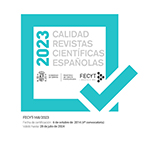Charles Tilly: Legado y estela De The Vendée a Contentious Performances, para comprender el conflicto político del s. XIX español
Resumen
Las últimas obras de Charles Tilly recapitulan, evalúan, concretan y proyectan hacia el futuro el legado empírico y teórico de una vida dedicada a la sociología histórica. Desde su opera prima sobre la Vendée hasta Contienda política y democracia en Europa, Tilly desarrolló y dio amplio y preciso contenido empírico a un conjunto de conceptos teóricos que hoy vertebran los estudios del conflicto político al inicio de la modernidad europea (entre otros, actuación, repertorio de acción colectiva, estructura de oportunidad política, mecanismos de movilización y, finalmente el despliegue de respetabilidad, unidad, número y compromiso ‒WUNC, en su acrónimo inglés). Su predilección por los métodos cuantitativos y comparativos perseguía explicar, no el motivacional por qué sino el objetivo cómo, cuándo y para qué de la movilización popular; no buscaba ‘leyes’ del cambio histórico, sino descripciones analíticamente fértiles de acontecimientos históricos semejantes, pero singulares y únicos. El paradigma metodológico que elaboró por vez primera en La Vendeé, analíticamente actualizado a través de su obra posterior, sirve aquí como marco para un nuevo abordaje de la movilización social y política que condujo a la primera guerra carlista, específicamente, mediante el estudio comparado de los mecanismos de movilización de recursos materiales y humanos para el esfuerzo de guerra en tres municipios navarros de características económicas, culturales y políticas bien diferenciadas.Descargas
Descarga artículo
Licencia
La revista Política y Sociedad, para fomentar el intercambio global del conocimiento, facilita el acceso sin restricciones a sus contenidos desde el momento de su publicación en la presente edición electrónica, y por eso es una revista de acceso abierto. Los originales publicados en esta revista son propiedad de la Universidad Complutense de Madrid y es obligatorio citar su procedencia en cualquier reproducción total o parcial. Todos los contenidos se distribuyen bajo una licencia de uso y distribución Creative Commons Reconocimiento 4.0 (CC BY 4.0). Esta circunstancia ha de hacerse constar expresamente de esta forma cuando sea necesario. Puede consultar la versión informativa y el texto legal de la licencia.











